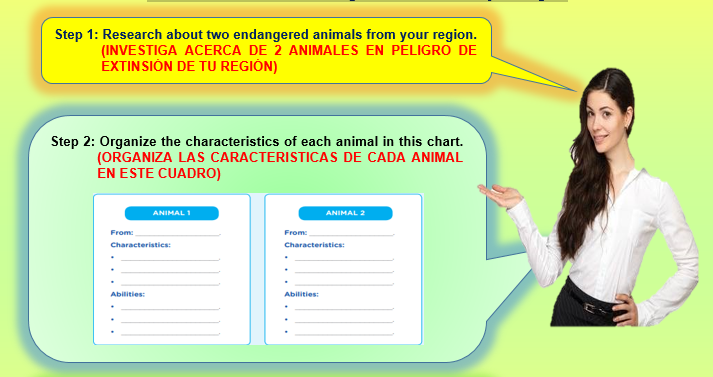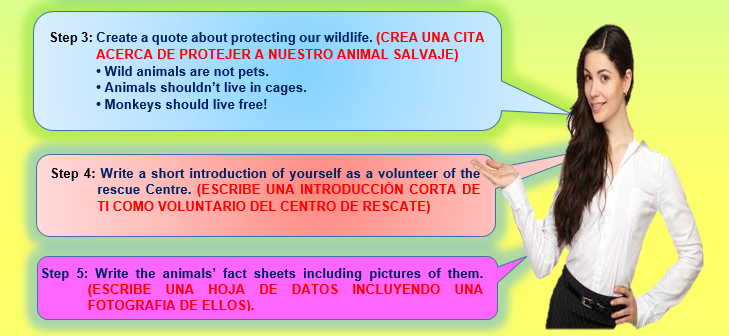
PLAY with the animals in this game..
Identify the object pronouns in the text and you write the story of an animal for a rescue centre’s web page.
THE OBJECT PRONOUNS

READ the stories of two rescued animals:


LET’S
UNDERSTAND

1. Naga was victim of poaching.
A) TRUE B) FALSE C) DOESN’T SAY
2. Naga is not in captivity anymore.
A) TRUE B) FALSE C) DOESN’T SAY
3.Sergio’s life was in danger at the restaurant.
A) TRUE B) FALSE C)
DOESN’T SAY
4.Sergio is now recovered and back in the rainforest again.
A) TRUE B) FALSE C)
DOESN’T SAY
LISTENING
COMPREHENSION
LISTEN to a conversation between Oliver and Marta. UNSCRAMBLE the pictures according to the story. One picture is NOT used. You will hear the conversation twice. Number one is the example:

1,__F__ 2. ______ 3. ______ 4. ______ 5. ______ 6. ______

LET’S CREATE!
As a volunteer you decided
to write the story of an animal for the rescue centre’s web page.
Write the
story about Felipe the dolphin.


Your story should have the following characteristics or criteria:
|
items |
Puntaje |
||||
|
1 |
2 |
3 |
4 |
5 |
|
|
La historia es acerca de un animal que
es rescatado y en tiempo pasado. |
|
|
|
|
|
|
La historia tiene al menos 5 partes y
usa la secuencia de palabras separándolas correctamente. |
|
|
|
|
|
|
La historia incluye los object
pronouns “ her – him” correctamente. |
|
|
|
|
|
|
La historia incluye imágenes relacionadas a la historia para
hacerlo mas atractivo. |
|
|
|
|
|
A. UNSCRAMBLE the story below. WRITE the letters in the correct order. Follow the example:
a. Then, she opened the
box and found three little cats.
b. After that, my aunt fed
them and took them to the veterinarian.
c. One day, my aunt heard
a noise coming from a box next to the garbage can.
d. Finally, my aunt took
them to a wildlife rescue centre.
e. When the veterinarian
saw them, he was very surprised. They were wild
Andean cats.
B.
COMPLETE the blanks with “he”, “she”, “him” or “her”.

|
Can
I do it? |
Not
at all |
Somewhat |
Well
|
Very
Well |
|
Can I understand key details in a
short story about rescued animal? |
|
|
|
|
|
Can I organize events in a story using
sequence words |
|
|
|
|
|
Can I replace nouns with object
pronouns correctly in a story? |
|
|
|
|
|
Can I make a story more attractive by
adding pictures about it? |
|
|
|
|















